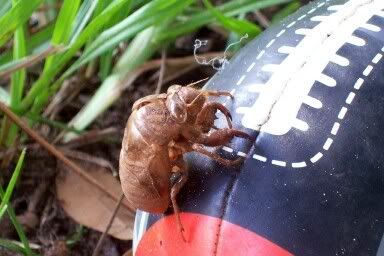
The kids were enjoying a little backyard time and next thing I know, "Moooom! Come and look, there's a bug the size of a potato!" Lol, well it's not the size of potato but just an exoskeleton of a some sort of beetle. I collected these when I was growing up so I called my mom to ask what it could be. Try katydid she said. Looked it up, nope. So can you tell me what this is? I always called them locusts. By the way, it claimed Danny's football, this was not staged. I'm a hero, you should have seen the pure amazement that I would reach down and pick up this weird looking potato buy like it was no big deal. Danny, who's only 3, said, "whoa!"
THANK YOU CAROLE!!! Thanks to Carole, see inside the comments, this has been correctly identified as a Cicada! A little impromptu science lesson for the kids. THANK YOU CHRISTIE! CHECK OUT THIS PHOTO OF A CICADA COMING OUT! http://boysplusacademy.blogspot.com/2007/07/cicada.html
A cicada also known as a "jar fly" is an insect of the order Hemiptera, suborder Auchenorrhyncha, in the superfamily Cicadoidea, with large eyes wide apart on the head and usually transparent, well-veined wings. There are approximately 2,500 species of cicada around the globe, and many remain unclassified. Cicadas live in temperate to tropical climates where they are one of the most widely recognized of all insects, mainly due to their large size and remarkable (and often inescapable) acoustic talents. Cicadas are sometimes incorrectly called "locusts"[1], although they are unrelated to true locusts, which are a kind of grasshopper. Cicadas are related to leafhoppers and spittlebugs. In parts of the southern Appalachian Mountains in the United States they are known as "dry flies" because of the dry shell they leave behind.
Cicadas do not bite or sting, are benign to humans, and are not considered a pest. Many people around the world regularly complement their standard diet with cicadas: the female is prized for eating as it is meatier. Cicadas have been eaten (or are still eaten) in Ancient Greece, China, Malaysia, Burma, Australia, Latin America and the Congo. Cicadas are employed in the traditional medicines of China and Japan for hearing-related matters.[citation needed]
The word cicada is a direct derivation of the Latin cicada. In classical Greek it was called a tettix, and in modern Greek tzitzikas.
http://en.wikipedia.org/wiki/Cicada




























13 comments:
It's a cicada (spelling? - pronounced si-ca-da). :) My brother used to like to collect them and line them up on the window screens.
I mean "si-cay-da"...
I'm so glad I'm not the only one who collected these as a child! You didn't by chance collect slugs too?
: ) Thank you Carole, Camille kept telling me to check to see if anyone had responded.
In WV we call them "Junebugs". When I looked it up though, a Junebug is a completely different kind of beetle all together! I think you'd be hard pressed to find an elderly person around here that would accept that though!
I always wondered about the "Junebug" thing as we don't hear them in the trees until August. I wonder if we'll find any this year?!
Keep an eye out on the ground near where you saw this one. It looks like the exoskeleton of a recently-emerged juvenile, so others should be emerging from the ground under the canopy of the tree. If you find one that looks like this, but is moving, put it in a jar and keep an eye on it. You'll be able to watch the bright, green, winged adult break out of this exoskeleton! It is very cool. (And a bit messy, so make sure you put it in a jar you don't want to keep! LOL!)
We always called them locusts shells as well. I have just recently learned that they are cicada's. Sis has a nice large collection of the shells that she keeps in the shed - in a 5 gal bucket - about an inch deep. She will be thrilled to know it is about time to start hunting for them again...Ry on the other hand - he refuses to touch them....lol!!!
and you know the noise you hear in the night - that sound at dusk when it is hot and you hear the buzz...that's a cicada.
That's funny. We've heard Cicadas for years now but this is the first up close picture I've seen. They are kinda creepy looking. LOL
I love it....Wiki says not considered a pest....that author has NEVER been in an outbreak (or whatever they call it). Every 14 or 17 years they hatch and if there's not been any construction during that time (digs up the dirt and kills the larvae) WATCH OUT!!! The noise is hideous and these huge things flying around are freaky!!!! But finding one or two, or even six or seven is not bad at all!
I drifted over here from a link at the WTM board...
And I'm so glad you posted this today!! For some reason, I have one that loves my garden hose. I had no idea what it was, so I hosed it away. About a week later, it was back. But now knowing it's a cicada, I don't think it was the same one... They don't live very long at all once they emerge from the ground.
I can't believe I didn't even think about it being a cicada. You're great for posting the picture! Yay!
Here's a really awesome cicada video you and your kids would enjoy. http://www.bio.indiana.edu/~hangarterlab/broodx/broodxmovies/NSFmovie.htm
Denise
Glad to be of assistance! (it's probably one of the only bugs that I can identify...)
You can see a picture of one emerging on my blog. DS5 took the picture on a walk one day.
http://boysplusacademy.blogspot.com/2007/07/cicada.html
Christie
Post a Comment